INSTITUT SUPERIEUR D'ANTHROPOLOGIE
INSTITUTE OF ANTHROPOLOGY
ONLINE COURSES / COURS A DISTANCE
NEW OPEN COURSE : JANUARY 2013
HRM 104 : INTRODUCTION TO INTANGIBLE CULTURAL HERITAGE
REGISTER NOW
ROYAUME UNI - 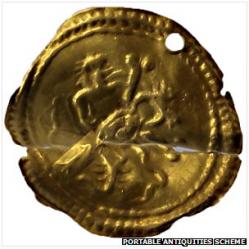
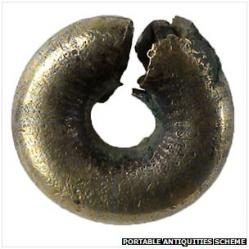 Keswick / Thompson - A gold earring disc, found in Norfolk by a metal detector enthusiast, has left treasure experts baffled as to the exact meaning of its decoration. Discovered in Keswick, near Norwich, the disc "is an unusual find for the Roman period", said a Norwich Castle Museum spokesman. It features a scorpion, phallus, snake and crab, but the meaning of the combination "is lost" an expert said. The Norwich museum hopes to acquire the disc for its collection. An inquest by Norfolk coroner William Armstrong also pronounced a copper alloy and gold penannular ring from the late Bronze Age as treasure. Dr Tim Pestell, senior curator of archaeology at Norwich Castle Museum, said: "They are more popularly known as ring money. "They weren't used as currency, but almost certainly as personal adornments with one theory being they were worn in the hair. "We've got a number of them in the castle collection already, but we felt because it's Bronze Age and gold we'd like to acquire it for the collection to show people." Ms Darch from the PAS added: "The complex construction of the pannanular ring demonstrates the skill and sophistication of metal working in the Bronze Age.
Keswick / Thompson - A gold earring disc, found in Norfolk by a metal detector enthusiast, has left treasure experts baffled as to the exact meaning of its decoration. Discovered in Keswick, near Norwich, the disc "is an unusual find for the Roman period", said a Norwich Castle Museum spokesman. It features a scorpion, phallus, snake and crab, but the meaning of the combination "is lost" an expert said. The Norwich museum hopes to acquire the disc for its collection. An inquest by Norfolk coroner William Armstrong also pronounced a copper alloy and gold penannular ring from the late Bronze Age as treasure. Dr Tim Pestell, senior curator of archaeology at Norwich Castle Museum, said: "They are more popularly known as ring money. "They weren't used as currency, but almost certainly as personal adornments with one theory being they were worn in the hair. "We've got a number of them in the castle collection already, but we felt because it's Bronze Age and gold we'd like to acquire it for the collection to show people." Ms Darch from the PAS added: "The complex construction of the pannanular ring demonstrates the skill and sophistication of metal working in the Bronze Age.
http://www.bbc.co.uk/news/uk-england-norfolk-20548502
TURQUIE – 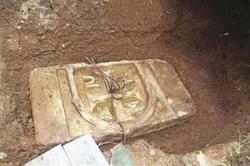 Yoros Castle - An inscription dating back to the sixth or seventh century that was stolen from Istanbul’s Yoros Castle has been found buried in a barn in the city’s Anatolian-side district of Beykoz. The head of the Yoros Castle excavations, Professor Asnu Bilban Yalçın, said they were disheartened by the theft but happy to have learned of the inscription’s discovery. “The inscription is a very significant part of the historic castle,” she said. The inscription, which has a cross on it, is thought to have been from the Eastern Roman period. Meanwhile, artwork from the Roman and Byzantine periods, including a tomb and pieces of a pillar, have been lost in the port of the Black Sea province of Bartın’s Amasra district, Doğan news agency has reported. There is much historic artwork among the rubble in the port, drawing concern from citizens. It is thought that the artwork, which have figures and Latin writing on them, were unloaded on the coast together with debris from construction. A Roman marble pillar with Latin alphabet text was taken under the protection of the Amasra Museum Directorate but another marble pillar with an ox figure on it and sarcophaguses were left on the coast. Officials declined to comment about the artifacts.
Yoros Castle - An inscription dating back to the sixth or seventh century that was stolen from Istanbul’s Yoros Castle has been found buried in a barn in the city’s Anatolian-side district of Beykoz. The head of the Yoros Castle excavations, Professor Asnu Bilban Yalçın, said they were disheartened by the theft but happy to have learned of the inscription’s discovery. “The inscription is a very significant part of the historic castle,” she said. The inscription, which has a cross on it, is thought to have been from the Eastern Roman period. Meanwhile, artwork from the Roman and Byzantine periods, including a tomb and pieces of a pillar, have been lost in the port of the Black Sea province of Bartın’s Amasra district, Doğan news agency has reported. There is much historic artwork among the rubble in the port, drawing concern from citizens. It is thought that the artwork, which have figures and Latin writing on them, were unloaded on the coast together with debris from construction. A Roman marble pillar with Latin alphabet text was taken under the protection of the Amasra Museum Directorate but another marble pillar with an ox figure on it and sarcophaguses were left on the coast. Officials declined to comment about the artifacts.
http://www.hurriyetdailynews.com/stolen-inscription-discovered-in-barn.aspx?pageID=238&nID=36354&NewsCatID=375
FRANCE – 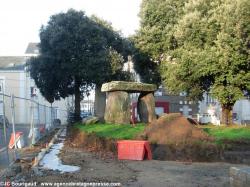 Saint Nazaire - Fin novembre, le groupe archéologique de Saint-Nazaire a découvert avec désolation une large tranchée creusée autour du dolmen Dolmen des Trois Pierres (Saint-Nazaire) allant jusqu'à mettre en danger des chênes verts plus que centenaires. Il dénonce des travaux effectués sans consulter la Direction Régionale des Affaires Culturelles (Drac) dans le périmètre d'un monument classé situé en centre-ville. Pour l'archéologue Emmanuel Mens ce chantier pose de sérieuses questions « car s'il y a un endroit où un paléosol a pu être conservé à Saint-Nazaire c'est bien sous le dolmen ou à ses abords immédiats. Il est évident que les aménagements se sont faits en dehors de toute surveillance par les services de l'État, et c'est bien cela le problème ». Le dolmen est en fait à l'origine un cairn qui dominait l'entrée de l'estuaire de la Loire non loin de l'ancien lit du Brivet. L'ingénieur et archéologue breton René Kerviler écrit à propos du “Dolmen” vestige d'un cairn - dans Armorique et Bretagne, recueil d'études sur l'archéologie, l'histoire et la biographie bretonne : « Dolmen du Prieuré, dans la nouvelle ville de Saint-Nazaire. C'est un immense trilithe, de deux mètres de hauteur et de 3,40 m de table, avec des débris de galerie couchés en arrière. On l'a conservé intact au milieu d'une petite place, au milieu d'un square ; et Saint-Nazaire est sans doute la seule ville qui possède un dolmen authentique dans ses murs. M. Carro en a donné deux lithographies assez exactes dans son Voyage chez les Celtes, Paris, Durand, 1857, in-8° ». Pour mémoire rappelons qu'en 1911 Henri Quilgars dressa un inventaire des mégalithes du Pays de Guérande. Pour Saint-Nazaire, il désigna 17 ensembles mégalithiques. G. de Saint-Loup précise qu'après la Seconde guerre mondiale, on peut cependant encore signaler : le tumulus du Pez, avec deux galeries, très ressemblant à celui de Dissignac ; il y a aussi les restes d'une allée couverte à Siril, dit la Pierre du Camp de La Piarde (il a été fouillé par Kerviler) ; Cuneix, et Ust, sont aussi des lieux qui n'ont jamais fait l'objet de fouilles, mais où on a repéré depuis longtemps des éléments néolithiques.
Saint Nazaire - Fin novembre, le groupe archéologique de Saint-Nazaire a découvert avec désolation une large tranchée creusée autour du dolmen Dolmen des Trois Pierres (Saint-Nazaire) allant jusqu'à mettre en danger des chênes verts plus que centenaires. Il dénonce des travaux effectués sans consulter la Direction Régionale des Affaires Culturelles (Drac) dans le périmètre d'un monument classé situé en centre-ville. Pour l'archéologue Emmanuel Mens ce chantier pose de sérieuses questions « car s'il y a un endroit où un paléosol a pu être conservé à Saint-Nazaire c'est bien sous le dolmen ou à ses abords immédiats. Il est évident que les aménagements se sont faits en dehors de toute surveillance par les services de l'État, et c'est bien cela le problème ». Le dolmen est en fait à l'origine un cairn qui dominait l'entrée de l'estuaire de la Loire non loin de l'ancien lit du Brivet. L'ingénieur et archéologue breton René Kerviler écrit à propos du “Dolmen” vestige d'un cairn - dans Armorique et Bretagne, recueil d'études sur l'archéologie, l'histoire et la biographie bretonne : « Dolmen du Prieuré, dans la nouvelle ville de Saint-Nazaire. C'est un immense trilithe, de deux mètres de hauteur et de 3,40 m de table, avec des débris de galerie couchés en arrière. On l'a conservé intact au milieu d'une petite place, au milieu d'un square ; et Saint-Nazaire est sans doute la seule ville qui possède un dolmen authentique dans ses murs. M. Carro en a donné deux lithographies assez exactes dans son Voyage chez les Celtes, Paris, Durand, 1857, in-8° ». Pour mémoire rappelons qu'en 1911 Henri Quilgars dressa un inventaire des mégalithes du Pays de Guérande. Pour Saint-Nazaire, il désigna 17 ensembles mégalithiques. G. de Saint-Loup précise qu'après la Seconde guerre mondiale, on peut cependant encore signaler : le tumulus du Pez, avec deux galeries, très ressemblant à celui de Dissignac ; il y a aussi les restes d'une allée couverte à Siril, dit la Pierre du Camp de La Piarde (il a été fouillé par Kerviler) ; Cuneix, et Ust, sont aussi des lieux qui n'ont jamais fait l'objet de fouilles, mais où on a repéré depuis longtemps des éléments néolithiques.
http://www.agencebretagnepresse.com/fetch.php?id=28446
INDE – Muziris - Contemporary art is opening a new road to connect to the heritage of the ancient Kochi-Muziris region of Keralto carry it to the world through a series of reconnecting works in a variety of mediums, on display at the Kochi-Muziris Biennale 2012. The ancient port city of Muziris - now being excavated - was a key transit point on the Indo-Roman and the Indo-Greek trade route since 1st century BC while its twin city Kochi has been a cultural melting pot for the last six centuries. The Kochi-Muziris Biennale 2012 - India's first official biennale of contemporary art beginning Dec 12 - is being described as a cultural renaissance built around the holistic heritage conservation model of regeneration, reuse and sustainability of archaeological relics, its organisers say. n a large dimly lit space at the Aspwin wall House in Mattancherry, the ancient spice trading quarters of Fort Kochi, a group of workmen is putting together what seems to be a strange installation. The workmen are assembling thousands of brown clay pottery shards, excavated from the ruins of Muziris in Pattanam, into an abstract miniature of the port city that was destroyed in a flood in the Periyar river in 1341 AD.
http://www.indiagazette.com/index.php/sid/211219640/scat/701ee96610c884a6
ROYAUME UNI –  Sheep Hill - An entire hill, famed for its archeological heritage and geological significance, is to be removed from the Scottish skyline to make way for a quarry under plans being considered by West Dunbartonshire Council. Sheep Hill, in the Kilpatrick Hills on the Clyde, is the site of ancient Bronze and Iron Age forts which local residents and experts say will be destroyed by the expansion of a stone quarry. Allowing the hill to be wiped off the map would be "an act of wanton destruction of our environment and inheritance", according to Clydebelt, a local environmental group, which is calling for Scottish ministers to intervene to save the hill. A proposal to revise mineral permission for an existing quarry run by a local firm near Sheep Hill is due to be discussed by West Dunbartonshire Council and has provoked fierce opposition from local groups. Silverton and Overtoun community council says digging away the hill would be irrevocable. "When Sheep Hill is gone, it is gone," said the council's Rose Harvie. "Future generations will look back and wonder how such destruction could have been permitted." Archaeologist Dr Euan MacKie has studied Sheep Hill since the 1960s. "It would be an act of appalling vandalism to destroy it," he said. He accused the quarry company of having little concern for the area's rich archaeological heritage, and the local authority of failing to capitalise on it. The quarry company, William Thompson & Son, which has extracted whinstone at its Sheep Hill quarry for decades did not respond to repeated requests to comment. A West Dunbartonshire Council spokesman said: "Sheep Hill is the site of a scheduled ancient monument. Scheduled ancient monument consent for the removal of Sheep Hill fort was granted in 2002."
Sheep Hill - An entire hill, famed for its archeological heritage and geological significance, is to be removed from the Scottish skyline to make way for a quarry under plans being considered by West Dunbartonshire Council. Sheep Hill, in the Kilpatrick Hills on the Clyde, is the site of ancient Bronze and Iron Age forts which local residents and experts say will be destroyed by the expansion of a stone quarry. Allowing the hill to be wiped off the map would be "an act of wanton destruction of our environment and inheritance", according to Clydebelt, a local environmental group, which is calling for Scottish ministers to intervene to save the hill. A proposal to revise mineral permission for an existing quarry run by a local firm near Sheep Hill is due to be discussed by West Dunbartonshire Council and has provoked fierce opposition from local groups. Silverton and Overtoun community council says digging away the hill would be irrevocable. "When Sheep Hill is gone, it is gone," said the council's Rose Harvie. "Future generations will look back and wonder how such destruction could have been permitted." Archaeologist Dr Euan MacKie has studied Sheep Hill since the 1960s. "It would be an act of appalling vandalism to destroy it," he said. He accused the quarry company of having little concern for the area's rich archaeological heritage, and the local authority of failing to capitalise on it. The quarry company, William Thompson & Son, which has extracted whinstone at its Sheep Hill quarry for decades did not respond to repeated requests to comment. A West Dunbartonshire Council spokesman said: "Sheep Hill is the site of a scheduled ancient monument. Scheduled ancient monument consent for the removal of Sheep Hill fort was granted in 2002."
http://www.stonepages.com/news/
TURQUIE – 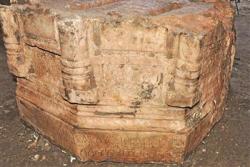 Harran - Traces from the Roman period have been found during restoration work in the Harran district of the southeastern province of Şanlıurfa. Harran is one of the oldest settlements in the world and was once the capital of the Assyrians and Emevis. Şanlıurfa Museum Director Müslüm Ercan said that Harran had been settled since the 6th century BC and they were undertaking archaeological excavations to revive the ancient structures in many parts of the city. Recent restoration work is continuing in the Harran Inner Castle, which was constructed by the Emevi ruler Mervan II in 750 A.D. and is made up of three storeys and 15 rooms. “As the Şanlıurfa Museum Directorate, we have started archaeological excavations to support the restoration. Now 70 workers are involved in the project. During the restoration work we have unearthed pillar drums, column headings and two tablets with Greek writing on it. The findings date back to the Roman period. We will try to read it,” he said.
Harran - Traces from the Roman period have been found during restoration work in the Harran district of the southeastern province of Şanlıurfa. Harran is one of the oldest settlements in the world and was once the capital of the Assyrians and Emevis. Şanlıurfa Museum Director Müslüm Ercan said that Harran had been settled since the 6th century BC and they were undertaking archaeological excavations to revive the ancient structures in many parts of the city. Recent restoration work is continuing in the Harran Inner Castle, which was constructed by the Emevi ruler Mervan II in 750 A.D. and is made up of three storeys and 15 rooms. “As the Şanlıurfa Museum Directorate, we have started archaeological excavations to support the restoration. Now 70 workers are involved in the project. During the restoration work we have unearthed pillar drums, column headings and two tablets with Greek writing on it. The findings date back to the Roman period. We will try to read it,” he said.
http://www.hurriyetdailynews.com/roman-traces-found-in-harran.aspx?PageID=238&NID=36271&NewsCatID=375